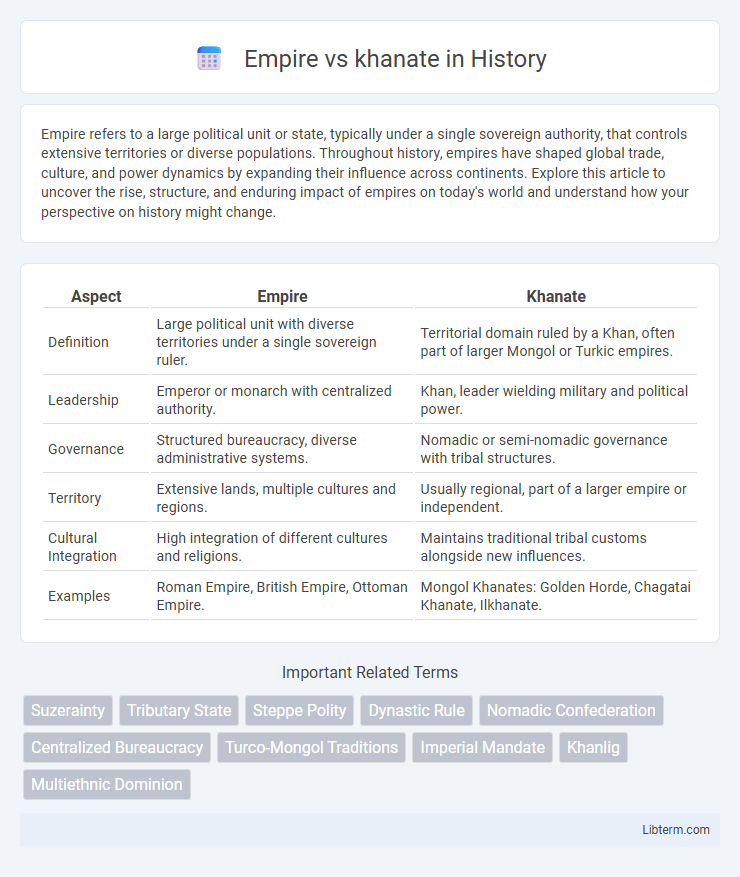Empire refers to a large political unit or state, typically under a single sovereign authority, that controls extensive territories or diverse populations. Throughout history, empires have shaped global trade, culture, and power dynamics by expanding their influence across continents. Explore this article to uncover the rise, structure, and enduring impact of empires on today's world and understand how your perspective on history might change.
Table of Comparison
| Aspect | Empire | Khanate |
|---|---|---|
| Definition | Large political unit with diverse territories under a single sovereign ruler. | Territorial domain ruled by a Khan, often part of larger Mongol or Turkic empires. |
| Leadership | Emperor or monarch with centralized authority. | Khan, leader wielding military and political power. |
| Governance | Structured bureaucracy, diverse administrative systems. | Nomadic or semi-nomadic governance with tribal structures. |
| Territory | Extensive lands, multiple cultures and regions. | Usually regional, part of a larger empire or independent. |
| Cultural Integration | High integration of different cultures and religions. | Maintains traditional tribal customs alongside new influences. |
| Examples | Roman Empire, British Empire, Ottoman Empire. | Mongol Khanates: Golden Horde, Chagatai Khanate, Ilkhanate. |
Defining Empires and Khanates
Empires are vast political entities characterized by centralized authority that govern diverse populations and territories often acquired through conquest and colonization. Khanates, typically emerging from Mongol or Turkic origins, represent semi-autonomous realms ruled by a khan, reflecting a decentralized power structure with strong tribal affiliations. Both forms signify complex governance systems but differ fundamentally in their administrative organization and cultural integration.
Historical Origins of Empires and Khanates
Empires historically emerged through the expansion of centralized states or kingdoms that exerted control over diverse territories, often through conquest and political assimilation, with the Roman and Persian Empires serving as archetypes. Khanates originated from the Mongol Empire's fragmentation in the 13th and 14th centuries, where military leaders known as Khans established autonomous regions like the Golden Horde, Ilkhanate, and Chagatai Khanate. These entities were characterized by tribal leadership structures, nomadic governance practices, and the role of lineage in maintaining authority.
Political Structures: Centralization vs Decentralization
Empires typically exhibit centralized political structures, with power concentrated in a single ruler or governing body that enforces uniform laws and policies across vast territories. Khanates often feature decentralized systems, where regional leaders or tribal chiefs maintain considerable autonomy under the nominal authority of a khan. This decentralization allows for flexible governance adapted to diverse cultural and geographical landscapes within the khanate.
Leadership: Emperors vs Khans
Emperors typically centralized power, embodying absolute authority within empires such as Rome and China, often relying on bureaucratic administration and hereditary succession to maintain control. Khans, like those of the Mongol Empire, combined military prowess with tribal leadership, frequently earning loyalty through personal valor and strategic alliances rather than rigid bureaucratic systems. The leadership styles highlight contrasting governance models: dynastic imperial rule versus charismatic and militaristic khanate command.
Military Organization and Strategies
Empires typically relied on centralized military hierarchies with professional standing armies, using complex logistics and diversified troop types such as infantry, cavalry, and siege units to maintain control over vast territories. Khanates emphasized highly mobile and flexible cavalry units skilled in hit-and-run tactics, leveraging superior horsemanship and archery to execute swift campaigns and adapt to varying terrains. Strategic use of steppe warfare, including feigned retreats and rapid encirclements, distinguished khanate military doctrine from the more rigid formation tactics of empires.
Economic Systems and Trade Networks
Empires often implemented centralized economic systems with state-controlled taxation and standardized currency to facilitate trade across vast territories, whereas khanates relied on more flexible, clan-based economic structures and informal tribute systems. Trade networks in empires were typically extensive and highly organized, linking diverse regions through well-maintained roadways and established marketplaces, while khanates capitalized on nomadic mobility to dominate steppe trade routes and caravan networks such as the Silk Road. Both systems fostered significant economic integration and cultural exchange, but empires emphasized bureaucratic regulation and infrastructure, contrasting with the khanates' reliance on decentralized control and opportunistic trade alliances.
Cultural Integration and Diversity
Empires typically achieved extensive cultural integration by imposing a centralized administration that promoted common languages, laws, and religions, fostering unity across diverse populations. Khanates, particularly those established by Mongol rulers, allowed a greater degree of cultural diversity and local autonomy, incorporating various ethnic groups and customs while maintaining control through tribute systems. This balance enabled khanates to preserve multicultural traditions within their domains, contrasting with the often homogenizing tendencies of empires.
Methods of Expansion and Control
Empires expand through centralized military conquest, sophisticated bureaucratic administration, and strategic alliances to integrate diverse populations under uniform governance. Khanates utilize swift cavalry raids, marital alliances, and flexible tribute systems to control vast, decentralized nomadic territories with minimal administrative infrastructure. Both employ methods of cultural assimilation and local elite cooperation to maintain long-term dominance over conquered regions.
Decline and Transformation
The decline of empires often involves administrative overreach, economic strain, and internal rebellions, while khanates typically face fragmentation due to succession conflicts and loss of centralized control. Empires transform through institutional reforms, decentralization, or assimilation of diverse cultures, whereas khanates either dissolve into smaller polities or evolve through alliances with emerging powers. Both entities demonstrate adaptive strategies to sustain influence but differ fundamentally in governance structures and responses to external pressures.
Legacy in Modern History
The legacy of empires versus khanates in modern history is evident in the political and cultural landscapes shaped by their governance and expansion strategies. Empires, such as the British and Roman, left behind centralized administrative systems and legal codes influencing contemporary statecraft, while khanates like the Mongol Empire pioneered vast trade networks and cultural exchanges across Eurasia, contributing to globalization's early development. Both legacies persist in modern national identities, border formations, and intercultural connections critical to understanding global historical dynamics.
Empire Infographic

 libterm.com
libterm.com